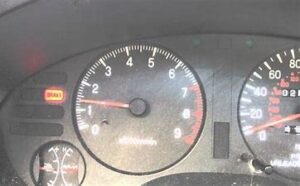- Does the engine rpm of your car fluctuate while driving? Does the rpm go up and down even when you are not accelerating? This may be caused due to many reasons like transmission slip, vacuum leak, faulty IAC, etc. A fluctuating rpm is not a good sign for your car’s health and should be fixed as soon as possible. in this article let us find out why your car rpm fluctuates while driving and how you can fix it yourself.
Table of Contents
What Is RPM?
RPM stands for revolutions per minute. An rpm meter (or tachometer) shows you how many times each of the engine pistons go up and down in the cylinder and the no. of rotations of the crankshaft every minute.
You must have observed on the tachometer that when you press the accelerator, the rpm goes up to a certain point. Also, there is a red line on the meter. If you increase the speed further without shifting gear, the needle goes beyond the red line and may damage the engine.

How Fix Engine RPM Fluctuations While Driving?
We will discuss in this article, all the possible reasons that cause the car rpm drops while idle or driving and look for its solutions. So, let’s start.
1. Check the IAC
The Idle Air Control Valve (IAC) controls the idle speed of the engine. It is controlled by a computer mechanism and any problem with the IAC may result in an unexpected engine stall i.e, your engine will give no response or fluctuate at high or low speeds resulting in rpm fluctuations.
How To Fix It?
The IAC is prone to carbon buildup. Therefore, cleaning the IAC would fix the problem. Also, look for any cracks or damage to it, if this is the case, you need to replace the IAC. Check out the video below for some more help on how to fix the IAC.
2. Check For Vacuum Leaks
The engine vacuum is an important component for the proper functioning of some important devices of our car. For example, the brake pedal effort is reduced because of the engine vacuum. The most important function of the engine vacuum is to maintain the air and fuel ratio in the engine for proper combustion. Therefore. if there is any vacuum leak, the air-fuel ratio may not be appropriate to maintain the proper rpm when you press the accelerator.
How To Fix It?
You can tell if there is a vacuum leak in the engine when you notice that the engine stalls unexpectedly at low speeds, or if there is too much leakage, you would hear hissing sounds from the engine. Vacuum leak should be diagnosed by a professional only, therefore, take your car to a mechanic to fix this problem. Check out the video below for some more information on the vacuum leak.
3. Check The Spark Plugs
The primary function of the spark plug is to ignite the air-fuel mixture in the engine. A faulty spark plug may cause a misfire, and heavy vibrations in the engine and the most common sign is engine fluctuations. Therefore, even a small component like a sparkplug may cause the rpm to go up and down while driving,.
How To Fix It?
Checking a faulty spark plug requires some special devices. So, take your car to a mechanic to fix this problem. But you can confirm that this is the problem by looking at some of the common signs mentioned earlier that your car gives when the spark plug is faulty. Also, check out the video below for some more help.
4. Check The Throttle Pedal Position Sensor (TPS)
The throttle pedal position sensor is a device that monitors the position of the throttle pedal. It also controls how much air should flow into the engine. If the TPS has become faulty, your car could accelerate unexpectedly without even pressing on the accelerator pedal, causing the rpm to fluctuate. The engine light on the dashboard would turn on when the TPS has become faulty.
How To Fix It?
Apart from the RPM fluctuates while driving, a bad TPS would cause issues like an unstable engine when idle, acceleration issues, high fuel consumption, etc. A TPS could be diagnosed by a mechanic only as it requires disassembling of various components. So, if you observe any of these signs in your car, take your car to a mechanic. You could try calibrating the gas pedal by yourself.
Turn off the engine, and slowly push the accelerator pedal completely touching the floor, the key should be off during this step. Now, turn the key on and release the pedal slowly. Now turn off the key. This would calibrate the throttle sensor to the right count. If your car’s rpm goes up and down while driving again take your car to a mechanic.
5. Check Engine Issues
If any of the other issues are not found, then the problem could be with the engine. If there is any issue in the combustion or power delivery of the engine, then this would be the cause for the rpm to fluctuate. Engine problems may also lead to higher fuel combustion, therefore, get this problem fixed immediately.
How To Fix It?
There may be a number of issues in your engine that may lead to rpm fluctuations. The engine light on the dashboard would turn on when this is the case. This problem could be diagnosed by a professional mechanic only, so get your car checked to fix this problem.
Things To Check When RPM Fluctuates While Driving
Here is a summary of all the components you should check when the RPM fluctuates while driving your car.
- Check The Idle Air Control Valve (IAC)
- Leakage in Engine Vacuum
- Faulty Spark Plugs
- Diagnose the Throttle Position Sensor (TPS), try calibrating the TPS yourself (refer to the steps mentioned in the TPS section in this article)
- Major Engine Problems
Frequently Asked Question Related to RPM Fluctuation:
So,here are some frequently Asked Questions about what are the causes,how much it fluctuate ,examples of RPM Fluctuations-
Can a Bad Crankshaft Sensor Cause Rpm to Fluctuate?
If the crankshaft position sensor is damaged, it can cause the RPM to fluctuate. Additionally, it may lead to the car stalling, long crank time before the engine starts, vibrations in the engine, or the engine might have trouble starting.
Can a Bad IAC Cause Your Rpm to Fluctuate?
This can lead to your car stalling out when you’re idling, and it can also lead to your RPM fluctuating wildly when you’re driving. You’re likely going to see that your RPM fluctuates while accelerating when you have a bad IAC.
How Much Should Your Rpm Fluctuate While Driving?
This range differs from one car to the next, but in general, having your RPM hover between 1,500 and 2,000 when you’re driving at a consistent speed is a good benchmark. But you should be worried if you see that your RPM fluctuates while accelerating in your car.
What Is an Example of a Rapid Rpm Change?
RPM’s rapidly fluctuate up and down even when on a flat road under constant throttle, speed and load. For example, RPM’s quickly move from 1,250 to 1,500 at 45 MPH.
Can a Vacuum Leak Cause a Car Rpm to Fluctuate?
An engine vacuum leak can also make your car’s RPM fluctuate. This leak usually occurs in the engine bay. Apart from your RPM fluctuating rapidly, other signs of a vacuum leak are a hissing sound, loss of power, low fuel efficiency, check engine light comes on, car stalling, and rough idle.
What should I do if my car rpm goes down to zero?
You should Check your fuel pump, Make it Throttle body clean, Make your injector clean, Check your RPM Sensor, Check your car Emulator, Check if there is any gas leakage near by your car engine.
Final Words
We have discussed all the possible reasons that cause rpm fluctuations in your car, and have looked for its solutions. Try to find out what may cause the problem in your car by identifying some signs that your car gives apart from the fluctuations. Do not try to disassemble any internal parts as it may lead to other complications.
If you like this article and have any queries, let us know in the comment section below.
Cheers!
![You are currently viewing How To Fix RPM Fluctuation While Driving [5 Ways]](https://hydraulicsuspension.com/wp-content/uploads/2022/04/download-9.jpg)


